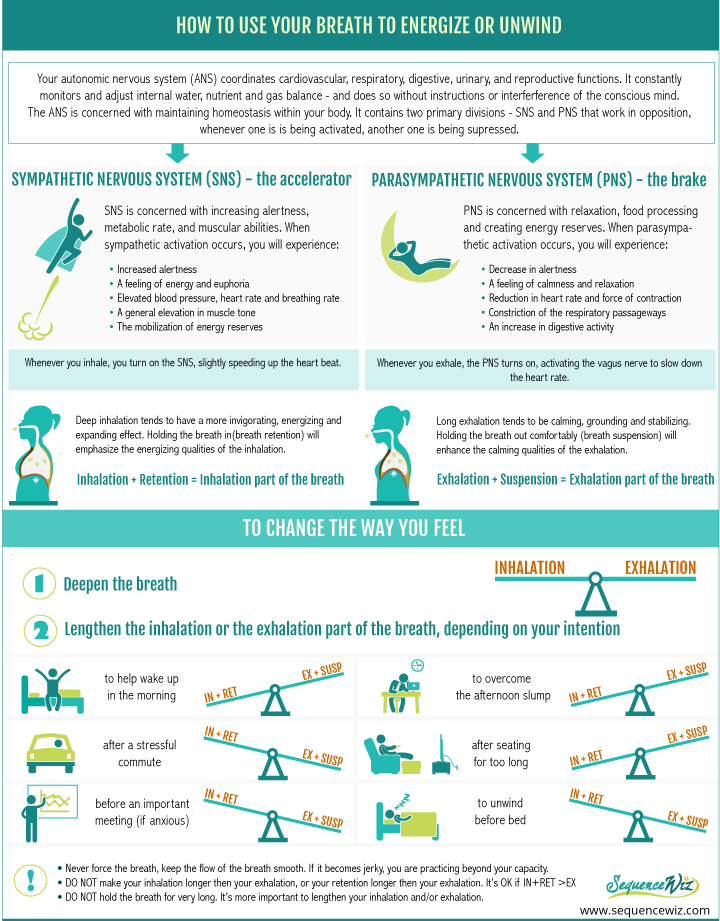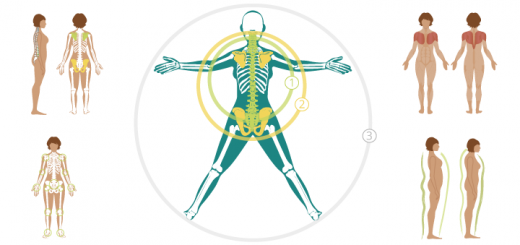A breathing trick: how to calm down before bed
3A few weeks ago, a student complained of trouble falling asleep. You know how it goes – you are lying there awake at 2am, mind still spinning. I suggested that she tried a simple breathing trick to see if it helps. The following week she reported that it had worked like a charm.
Here is the trick to calm down before bed. Get settled in bed and relax your body first. Then bring your attention to your breath.
1. Exhale: (say mentally): “One breath at a time” and relax the body; do that for 3-4 breaths.
2. Exhale: (say mentally) “One full breath at a time” and relax the body; repeat for 3-4 breaths.
3. Exhale: (say mentally) “One full deep breath at a time”; 3-4 cycles.
4. Exhale (say mentally) “One full deep relaxed breath at a time”. Continue repeating it mentally with every exhalation, relaxing your body and making sure that you are not straining your breath. Hopefully, the next thing you notice is the morning light in your windows. Of course, it won’t work for everyone, but this is an example of how you can use the length of your exhalation to activate your PNS and facilitate the relaxation response.
PNS (parasympathetic nervous system) is a branch of ANS (autonomic nervous system) that operates largely outside of our awareness. ANS regulates individual organ function and homeostasis. ANS includes a sympathetic division (SNS) concerned with increasing alertness, metabolic rate, and muscular abilities, and parasympathetic division (PNS), which is mostly concerned with relaxation, food processing and creating energy reserves.
Whenever you inhale, you turn on the SNS, slightly speeding up the heart beat; when you exhale, the PNS turns on, activating the vagus nerve to slow down the heart rate. Lengthening your inhalation will have a more pronounced energizing effect, while lengthening your exhalation will have a more pronounced sedating effect.
Generally speaking, deep inhalation tends to have a more invigorating, energizing and expanding effect; and long exhalation tends to be more calming, grounding and stabilizing. In our yoga practice we can choose to emphasize one or the other, depending on what we are trying to accomplish.
Why does it matter? Well, in the course of your day you might find yourself in need of more vigor or more calm. For example, most of us need a little more boost in the morning and some general calming at night. You might need to increase your alertness before an important meeting or unwind yourself after a stressful commute. Certain health conditions are associated with too much stimulation (like anxiety or insomnia), and certain ones with not enough stimulation (like depression or Seasonal Affective Disorder). Certain medications can also overstimulate or sedate the system.
We know that the way we feel affects the way we breathe. But it works the other way around, as well – by changing the way we breathe, we can change how we feel. How do we do that? Deepening the breath in general is the first step. As we become more aware, we can become much more specific in our fine-tuning, and work on lengthening the inhalation or the exhalation, depending on the situation.
Yoga tradition also talks about kumbhaka, which means breath retention. You can hold your breath in or out, so my teacher Gary Kraftsow adopted two different words to describe those pauses, since they have very different energetic effects. We use the word “retention” to describe the pause after the inhalation (since you are retaining your breath), and the word “suspension” to describe hold after the exhalation (since the breath is in a suspended state until the next one begins). Energetically speaking, retention (holding the breath in) will emphasize the energizing qualities of the inhalation, and suspension (holding the breath out) will enhance the calming qualities of the exhalation.
In fact, Yoga sutra 1.34 talks about the importance of the pause after exhalation in mind centering and promoting the sense of calm. In one of the translations I saw it called a “doorway to serenity” and my students tend to echo that sentiment. “I felt so at peace in that pause, that I never wanted to come out” – is a common feedback I get after working with suspension in a yoga class.
When we design a yoga practice with a purpose of changing our energy or physiology, we need to consider all four parts of the breath – inhalation, retention, exhalation and suspension – and their proportional relationship to each other. This is called the science of ratio, and you don’t need to be a mathematician to understand it. Traditionally, yogis have used mantra to measure the length of the breath. It would work similarly to the example that I’ve discussed earlier (“One breath at a time”), you would just gradually add more words to it to make it longer and longer. If you add a pause after the exhale, you would enhance the effect even more. If we wanted to record the same example in a numeric fashion (in seconds), it would probably look something like this:
Inhalation : Retention : Exhalation : Suspension
1. 6:0:6:0 – 4 breaths
2. 6:0:7:0 – 4 breaths
3. 6:0:8:0 – 4 breaths
4. 6:0:8:2 (if you added a pause) – 4 breaths
5. 6:0:8:4 (if you lengthened the pause) – 4 or more breaths
This is an example of building a ratio – progressively lengthening the parts of the breath that you are interested in lengthening. If you look at the final ratio (6:0:8:4), you will see that the inhalation part of the breath is 6 seconds (6+0=6) and exhalation part of the breath is 12 seconds (8+4=12) which makes the exhalation part twice as long – this will emphasize the effect even more. As a result your PNS turns on and helps you calm down before bed. If you would like more information on how to build ratios, cautions and specific applications, check out Yoga for Transformation by Gary Kraftsow.
You can work with simple ratios during your asana practice and formal pramayama practice – in fact, it will be more effective if you do both, building your ratio gradually. Once you choose the breathing pattern that you want to work with, you can augment it with your choice of poses, the pace you set for the class, the tone of your voice, etc. This will be the topic of our conversation next week along with some examples of energizing and calming practices. Tune in!
![]()























Hi olga,
thank you for the great amount of information on you website. I learn so much.
I am studying the vagus nerve/ PNS and ratio breathing and have a question. It appears that the seesaw illustration above shows that the inhale/retention can be higher than the exhale/suspension for activation and energizing. The part that is confusing is your warning of not making the inhale longer than the exhale. Could you please explain ? Thank YOu
Hi Mary, thank you for your comment! I can see where this is confusing. In Viniyoga tradition we generally say that we don’t want the inhalation to be longer than the exhalation. However, the combination of Inhalation + Retention can be longer than Exhalation + Suspension. For example, a ration of 8:4:8:0 means inhale for 8sec, retain for 4 sec, exhale for 8 sec, do not suspend. In this example, IN=EX, but IN+RET=12 sec, EX+SUSP=8sec, so IN+RET > EX+SUSP. This will have an energizing effect on the system. Does that make sense?
Thank you. yes it makes sense!